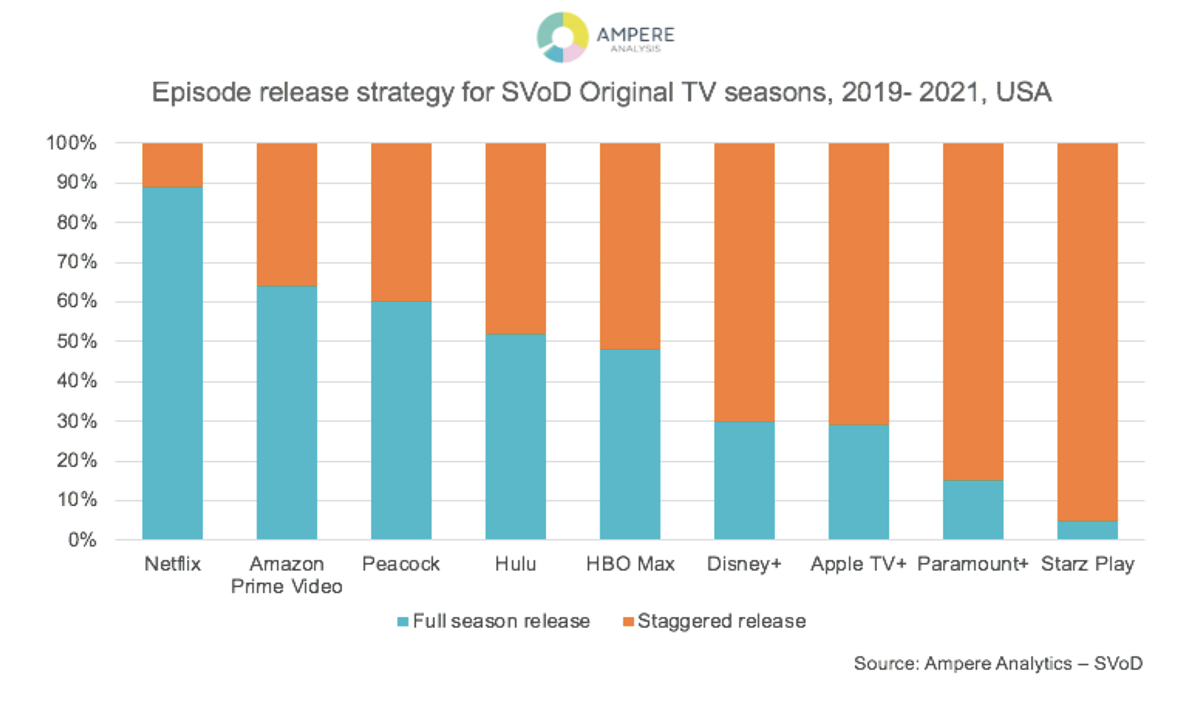
READ MORE: Binge watch or watch weekly? (Ampere Analytics)
Part of the cult success of hit shows like Showtime’s Yellowjackets or the BBC’s Line of Duty has been the space of time for fans to speculate on what comes next. Word-of-mouth amplified the show’s impact. According to a new report from Ampere Analytics, this is only possible with a more traditional weekly drop of episodes that helps ensure longevity in engagement more than a full season release would for the same content.
The report explains that “a weekly release schedule limits subscriber churn and better maintain engagement with content over time… The strategy is also helping to eke out perceived value in smaller catalogues.”
While the major streamers have tended to follow Netflix’s strategy of full season releases for binge watching, Ampere notes that a wave of new SVOD platforms are employing the classic model of gradual episode releases — but that the trend may be only temporary.
“One reason for new platforms to break from the mold set by the market leader is the size of the overall on-demand library. At launch, the US Disney+ catalogue was 10% the size of Netflix’s by total duration, while HBO Max’s was 26% and Apple TV+’s less than1%. The number of flagship Originals available in the first months of launch was also limited, especially due to delays caused by COVID-19-related production shutdowns.”

Ampere’s report notes that “a weekly release strategy across a range of high-profile Originals reduces the risk of churn over time. For example, Disney+ released episodes of new Marvel Cinematic Universe TV shows across 34 weeks in 2021.” That means that a Marvel fan who wanted to avoid spoilers “would have to subscribe to Disney+ for the majority of the year to watch each episode at the earliest opportunity.”
Ampere also indicates that engagement with a TV show decays faster for full-season releases when indexed against their popularity at launch. Comparing top Netflix full-season releases and HBO weekly releases, the popularity of Netflix shows dropped to 80% of within one month of release compared to HBO series, which took four months.
“A weekly release pattern more easily facilitates conversation around a show,” comments Rahul Patel, Ampere Senior Analyst. “Between episodes, viewers have ample time to discuss and re-watch episodes, which is less likely to be the case if an entire season is released together. Hence, weekly releases can lessen the chance of engagement with a show decaying rapidly after its initial release.
“By extension, weekly releases can benefit lower profile titles — particularly those not based on recognizable Intellectual Property — as positive word of mouth sentiment has more time to build and spread. By releasing the totality of an unknown season in one stroke, a platform runs the risk of the title being crowded out in an increasingly competitive content market.”
CHARTING THE GLOBAL MARKETPLACE:
Big content spends, tapping emerging markets, and automated versioning: these are just a few of the strategies OTT companies are turning to in the fight for dominance in the global marketplace. Stay on top of the business trends and learn about the challenges streamers face with these hand-curated articles from the NAB Amplify archives:
- How To Secure the Next Billion+ Subscribers
- Think Globally: SVOD Success Means More Content, Foreign Content and Automated Versioning
- How Does OTT Gain Global Reach? Here’s Where to Start.
- Governments Draw Battlelines To Curb the US Domination of SVOD
- Streaming Content: I Do Not Think You Know What That Word Means




